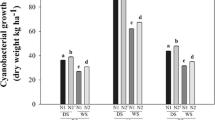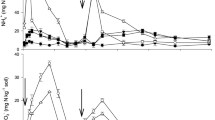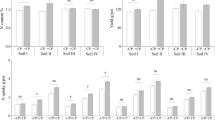Abstract
This paper reports a study, in a flooded rice field in Thailand, on the effects of two urease inhibitors, cyclohexylphosphorictriamide (CHPT) and N-(n-butyl)phosphorictriamide (NBPTO), the nitrification inhibitor phenylacetylene and an algicide treatment, consisting of alternate additions of copper sulfate and terbutryn at ~3 day intervals, on nitrogen (N) transformations and transfers, and grain yield. The addition of algicide reduced the growth of algae and maintained the pH of the floodwater below that of the control for 11 days. Judging from the ammoniacal N concentrations of the floodwater, phenylacetylene inhibited nitrification. The two urease inhibitors markedly reduced urea hydrolysis and CHPT was more effective than NBPTO. Addition of CHPT maintained the ammoniacal N concentration of the floodwater below 2 g m−3 for 11 days and reduced ammonia loss by ~90%. All urease inhibitor treatments in combination with algicide and / or nitrification inhibitor significantly (p < 0.05) increased the recovery of applied N by the plant. Addition of NBPTO or CHPT in combination with phenylacetylene and algicide resulted in a 2 or 3 fold increase of applied N in the grain, and significantly (p < 0.05) increased grain yield.
Similar content being viewed by others
References
Beyrouty CA, Sommers LE and Nelson DW (1988) Ammonia volatilization from surface-applied urea as affected by several phosphoroamide compounds. Soil Sci Soc Am J 52: 1173–1178
Bowmer KH and Muirhead WA (1987) Inhibition of algal photosynthesis to control pH and reduce ammonia volatilization from rice floodwater. Fert Res 13: 13–29
Bremner JM (1965) Total nitrogen. In: Black CA (ed) Methods of Soil Analysis Part 2, pp 1149–1178. Am Soc Agron, Madison, WI
Bremner JM and Chai HS (1986) Evaluation of N-(n-butyl) phosphorothioic triamide for retardation of urea hydrolysis in soil. Commun Soil Sci Plant Anal 17: 337–351
Bronson KF, Touchton JT, Hiltbold AE and Hendrickson LL (1989) Control of ammonia volatilization with N-(n-butyl) thiophosphoric triamide in loamy sands. Commun Soil Sci Plant Anal 20: 1439–1451
Buresh RJ, De Datta SK, Padilla JL and Chua TT (1988a) Potential of inhibitors for increasing response of lowland rice to urea fertilization. Agron J 80: 947–952
Buresh RJ, De Datta SK, Padilla JL and Samson MI (1988b) Field evaluation of two urease inhibitors with transplanted lowland rice. Agron J 80: 763–768
Byrnes BH and Christianson CB (1988) Development of a urease inhibitor from N-(n-butyl)thiophosphoric triamide. Agron Abs. p 212
Byrnes BH, Savant NK and Craswell ET (1983) Effect of a urease inhibitor phenyl phosphorodiamidate on the efficiency of urea applied to rice. Soil Sci Soc Am J 47: 270–274
Cai GX, Zhu ZL, Trevitt ACF, Freney JR and Simpson JR (1886) Nitrogen loss from ammonium bicarbonate and urea fertilizers applied to flooded rice. Fert Res 10: 203–215
Cai GX, Freney JR, Muirhead WA, Simpson JR, Chen DL and Trevitt ACF (1989) The evaluation of urease inhibitors to improve the efficiency of urea as a N-source for flooded rice. Soil Biol Biochem 21: 137–145
Cao ZH, De Datta SK and Fillery IRP (1984) Effect of placement methods on floodwater properties and recovery of applied nitrogen (15N-labeled urea) in wetland rice. Soil Sci Soc Am J 48: 196–203
Chai HS and Bremner JM (1987) Evaluation of some phosphoroamides as soil urease inhibitors. Biol Fertil Soils 3: 189–194
Chaiwanakupt P, Freney JR, Keerthisinghe DG, Phongpan S and Blakeley RL (1995) Use of urease and nitrification inhibitors to reduce nitrogen loss and increase grain yield of flooded rice. Biol Fertil Soils (In press)
Cristianson CB, Byrnes BH and Carmona G (1990) A comparison of the sulfur and oxygen analogs of phosphoric triamide urease inhibitors in reducing urea hydrolysis and ammonia volatilization. Fert Res 26: 21–27
Craswell ET, De Datta SK, Obcemea WN and Hartantyo M (1981) Time and mode of nitrogen fertilizer application to tropical wetland rice. Fert Res 2: 247–259
Creason GL, Schmitt MR, Douglass EA and Hendrickson LL (1990) Urease inhibitory activity associated with N-(n-butyl)thiophosphoric triamide is due to formation of its oxon analogue. Soil Biol Biochem 22: 209–211
De Datta S K (1987) Advances in soil fertility research and nitrogen fertilizer management for lowland rice. In: Freney JR, Wetselaar R, Trevitt ACF and Simpson JR (eds) Efficiency of Nitrogen Fertilizers for Rice, pp 27–41. International Rice Research Institute, Los Baños, Phillipines
De Datta SK, Trevitt ACF, Freney JR, Obcemea WN, Real JG and Simpson JR (1989) Measuring nitrogen losses from lowland rice using bulk aerodynamic and nitrogen-15 balance methods. Soil Sci Soc Am J 53: 1275–1281
Denmead OT (1983) Micrometeorological methods for measuring gaseous losses of nitrogen in the field. In: Freney JR and Simpson JR (eds) Gaseous Loss of Nitrogen from Plant - Soil Systems, pp 133–157. Martinus Nijhoff/Dr W Junk Publishers, The Hague
Fillery IRP and Vlek PLG (1986) Reappraisal of the significance of ammonia volatilization as an N loss mechanism in flooded rice fields. Fert Res 9: 79–98
Fillery IRP, Simpson JR and De Datta SK (1984) Influence of field environment and fertilizer management on ammonia loss from flooded soil. Soil Sci Soc Am J 48: 914–920
Fillery IRP, Simpson JR and De Datta SK (1986) Contribution of ammonia volatilization to total nitrogen loss after application of urea to wetland rice fields. Fert Res 8: 193–202
Freney JR and Denmead OT (1992) Factors controlling ammonia and nitrous oxide emissions from flooded rice fields. Ecol Bull 42: 188–194
Freney JR, Leuning R, Simpson JR, Denmead OT and Muirhead WA (1985) Estimating ammonia volatilization from flooded rice fields by simplified techniques. Soil Sci Soc Am J 49: 1049–1054
Freney JR, Trevitt ACF, De Datta SK Obcemea WN and Real JG (1990) The interdependence of ammonia volatilization and denitrification as nitrogen loss processes in flooded rice in the Philippines. Biol Fertil Soils 9: 31–36
Keerthisinghe DG and Freney JR (1994) Inhibition of urease activity in flooded soils: Effect of thiophosphorictriamides and phosphorictriamides. Soil Biol Biochem 26: 1527–1533
Kolc JF, Swerdloff MD, Rogic MM, Hendrickson LL and Van der Puy M (1985) N-aliphatic and N, N-aliphatic phosphoric triamide urease inhibitors and urease inhibited urea based fertilizer combinations. U.S. Patent 4530714
Leuning R, Freney JR, Denmead OT and Simpson JR (1985) A sampler for measuring atmospheric ammonia flux. Atmos Environ 18: 1583–1592
Luo Qui-xiang, Freney JR, Keerthisinghe DG and Peoples MB (1994) Inhibition of urease activity in flooded soils by phenylphosphorodiamidate and N-(n-butyl)thiophosphorictriamide. Soil Biol Biochem 26: 1059–1065
McCarty GW, Bremner JM and Chai HS (1989) Effect of N-(n-butyl) thiophosphoric triamide on hydrolysis of urea by plant, microbial, and soil urease. Biol Fertil Soils 8: 123–127
McCarty GW and Bremner JM (1986) Inhibition of nitrification in soil by acetylenic compounds. Soil Sci Soc Am J 50: 1198–1201
Muirhead WA, De Datta SK, Roger PA and Gusto RM (1989) Effect of algicides on urea fertilizer efficiency in transplanted rice. I. Floodwater chemistry and biota. Fert Res 21: 95–107
Mulvaney RL and Bremner JM (1979) A modified diacetylmonoxime method for colorimetric determination of urea in soil extracts. Commun Soil Sci Plant Anal 10: 1163–1170
Orion (1983) Instruction Manual for Ammonia Electrode Model 95-12. Orion Research Inc, Cambridge, Mass
Phongpan S and Byrnes BH (1990) The effect of the urease inhibitor N-(n-butyl) thiophosphoric triamide on the efficiency of urea application in a flooded rice field trial in Thailand. Fert Res 25: 145–151
Phongpan S, Freney JR, Keerthisinghe DG and Chaiwanakupt P (1995) Use of phenylphosphorodiamidate and N-(n-butyl)thiophosphorictriamide to reduce ammonia loss and increase grain yield following application of urea to flooded rice. (Fert Res) (In press)
Rodgers GA (1983) Effect of dicyandiamide on ammonia volatilization from urea in soil. Fert Res 4: 361–367
Schnier HF, De Datta SK, Fagi AM, Eaqub M, Faruque Ahmed, Tejasarwana R and Mazid A (1993) Yield response of wetland rice to band placement of urea solution in various soils in the tropics. Fert Res 36: 221–227
Schlegel AJ, Nelson DW and Sommers LE (1986) Field evaluation of urease inhibitors for corn production. Agron J 78: 1007–1012
Simpson JR, Freney JR, Wetselaar R, Muirhead WA, Leuning R and Denmead OT (1984) Transformations and losses of urea nitrogen after application to flooded rice. Aust J Agric Res 35: 189–200
Simpson JR, Freney JR, Muirhead WA and Leuning R (1985) Effects of phenylphosphorodiamidate and dicyandiamide on nitrogen loss from flooded rice. Soil Sci Soc Am J 49: 1426–1431
SMSS (1983) Keys to Soil Taxonomy. Soil Management Support Services, Technical Monograph No 6, United States Department of Agriculture. US Government Printing Office, Washington
Stangel PJ and Harris GT (1987) Trends in production, trade and use of fertilizers: A global perspective. In: Freney JR, Wetselaar R, Trevitt ACF and Simpson JR (eds) Efficiency of Nitrogen Fertilizers for Rice, pp 1–26. International Rice Research Institute, Los Baños, Philippines
Vlek PLG and Byrnes BH (1986) The efficacy and loss of fertilizer N in lowland rice. Fert Res 9: 131–147
Zhu ZL, Cai GX, Simpson JR, Zhang SL, Chen DL, Jackson AV and Freney JR (1989) Processes of nitrogen loss from fertilizers applied to flooded rice fields on a calcareous soil in north-central China. Fert Res 18: 101–115
Author information
Authors and Affiliations
Rights and permissions
About this article
Cite this article
Freney, J.R., Keerthisinghe, D.G., Phongpan, S. et al. Effect of urease, nitrification and algal inhibitors on ammonia loss and grain yield of flooded rice in Thailand. Fertilizer Research 40, 225–233 (1994). https://doi.org/10.1007/BF00750469
Received:
Accepted:
Issue Date:
DOI: https://doi.org/10.1007/BF00750469




